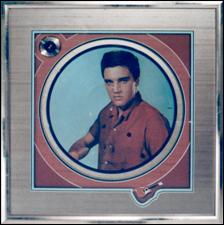 Photo 1
Photo 1
Strong juxtaposed shapes are used, contrasting the square and circular forms with small objects upper left, lower right; a good example of shape in design.
Shape is an element integral to design. It creates beauty, refines craftsmanship and reinforces unity. Artists use shapes to develop the illusion and fantasy inherent in art. Framers use more tangible objects, such as mats and frames, in the form of shapes to complete their presentations, as the guitar Elvis (photo 1-1A).
 Photo 1
Photo 1
Strong juxtaposed shapes are used, contrasting the square and circular forms with small objects upper left, lower right; a good example of shape in design.
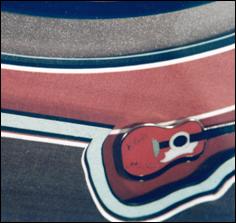 Photo 1a
Photo 1a
The cutouts echo the object shapes and establish "shape" as a dominant design element.
Shapes are areas which stand out from the space surrounding them because of a defined boundary, generally created by other elements such as line, color or texture (photo 2). They are readily recognized as known objects and are actual geometric or physical forms consisting of height and weight. Thus, shape defines a specific area. It communicates ideas and emotions to the viewer and often is used as a vehicle to stimulate or excite.
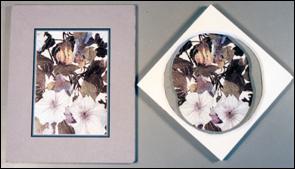 Photo 2
Photo 2
The left rectangular samples is a "given" and does not use shape as a countable element.
The sample right featuring a square at the diamond and the free form inner window integrates shape as a huge design statement.
Natural Shape
There are four basic shape categories...natural, geometric, abstract and non-objective. Natural shapes make up all of our surroundings, they are anything found in Nature. Plants, animals and humans are natural non-created shapes. Natural shapes (not man-made) may also be characterized as geometric.
Framing with Geometric Shapes
Geometric shapes are comprised of triangles, squares, circles etc. and are closely related to architecture or in this case framing. Rectangular, square, hexagon, round, oval, and multiple opening mats all constitute use of geometric shape as an element in mat design (photo 3). Frames that are multi-sided, oval, rectangular, offset etc. also create geometric shapes, but with mouldings.
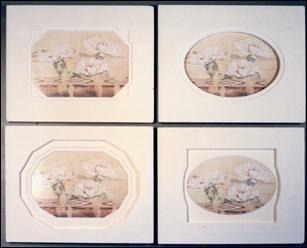 Photo 3
Photo 3
The left rectangular samples is a "given" and does not use shape as a countable element.
The sample right featuring a square at the diamond and the free form inner window integrates shape as a huge design statement.
Framing uses shape as the perimeter surrounding artwork, creating its border. Frames present the germ of a mood depending upon their degree of rectangularity. Horizontal shapes within an artwork, such as a landscape, predominate within a horizontal frame unit. Vertical images grow upward if placed within a vertical frame format.
Maintaining or reinforcing the shapes within art creates a harmony between the frame and its contents. It also emphasizes the mood of the original shapes of the artist's images, as the strong near vertical Japanese brush stroke is reinforced by the square frame hung at a diagonal (photo 4). Therefore, specific designer selections of matboard openings and/or moulding perimeter shapes are extremely important. They may either reinforce the original "feeling" or throw the entire presentation into an unsettling visual arena.
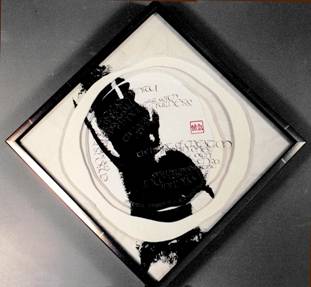 Photo 4
Photo 4
A square frame on the diagonal sets off the inner mats, echoing the curved lettering but also reinforcing the bold sumi brush stroke.
This frame design was created by the artist.
Abstract and Non-Objective Shapes
Natural shapes reduced down to their essence become stylized or abstracted. American Indians have used religious, earth and animal forms converted into distinctive abstractions and patterns, which often have very specific symbolic meanings. These shapes are used as designs on pottery, weavings and jewelry. They emulate natural forms yet evolve into abstracted patterns of their originals.
Non-objective shapes are those that don't originate in any recognizable shape or object. Though they may have been stimulated by an actual natural form such as the human body, the resulting design no longer visually resembles the original, upon which it was based. This is most notable in many contemporary artists and some of the later paper projects by Matisse.
Psychological Meanings of Shapes
For centuries, psychologists have been studying the human mind and it's reaction to visual shape stimulus. Ink blot responses attempt to standardize human reaction, feeling and emotion in connection with specific lines, colors and values that create non-objective shapes.
These studies have determined that although it remains somewhat individualized, squares generally equate a feeling of perfection, stability, symmetry and self-reliance. Rectangles stretch those emotions into a more solid base as a result of the stronger horizontal. There is also a tendency to soften the rigidity and perfection a bit, so it feels more relaxed.
Controlled Attention
Compositional balance must be considered when arranging shapes within a confined unit, frame or shadow box. Dark, dense shapes appear heavier and attract greater attention. Shapes of intense color must also be offset to adjust the visual balance within a frame.
A single portrait dressed in dark clothing amidst a multiple opening mat of light colored portraits will be the first photo seen. This dark shape will dominate even if all the images are the same opening dimensions. The desired end product utilizes what is known as controlled tension to direct or balance the images. Visual interest and balance must be achieved or the design is doomed to failure. Good art will already contain this necessary element, but object boxes, multiple openings, and wall groupings must be controlled by the framing designer.
Shape Dominance
The concept of controlled tension, or arranging the shapes properly to evoke comfortable viewer emotions, leads directly into controlled vision or shape dominance. The idea is to gently guide the viewer's attention (vision) from one element or object in a frame to another on a directed course. This in turn stimulates use of other elements such as rhythm and movement. The determination of visual importance or controlled vision of an object, photo or framed unit may easily be manipulated by shape, either by the outer frame perimeter or the inner mat opening.
A single oval opening amidst a sea of eleven rectangular openings in a multi-opening mat will attract shape dominance, or greater visual importance. Three oval openings with seven rectangular and two square openings will most likely balance the visual dominance depending upon the location of the shapes within the frame (diagram 1).
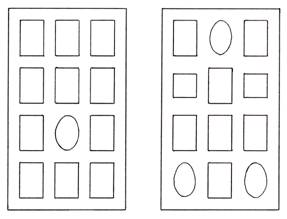 Diagram 1
Diagram 1
Left, a single oval may dominate a sea of rectangles. Right, a variety of oval placement and assorted squares and rectangles uses shape in a more balanced presentation.
In either example shape would be counted as an element.
The size, subject and surface decoration involving line, color, etc. also add to shape dominance. An oval surrounding a portrait will often dominate an oval surrounding a garden snapshot. An oval opening would also have less visual strength, if there were ruling pen or tiered mat lines, surrounding several rectangles, even if it were the only oval in a twelve opening mat.
Since a shape consists of a border or outline and visual control is the goal in framing, if you elect to showcase shape as an element through pen lines, tiered mats, cathedral mat, or offset corners, the execution must be clean and perfected (photo 5). The parallel between the diagonal within the image and the v-groove qualifies shape as an element. The idea is to make a statement so shape becomes recognized as an elected element within the design and countable in your 3-5 limitation.
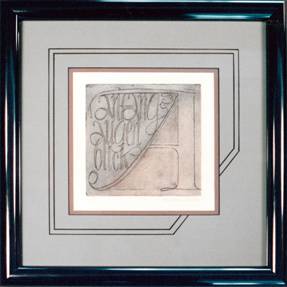 Photo 5
Photo 5
The accented double v-groove lines echo the shape in the etching. Line, color, and shape are elements in this design.
Shape and Mass
Shape is a 2-dimensional design, mass is the 3-dimensional version of the same thing. In life, they are essentially inseparable. The same four types of shape are found in mass (natural, geometric, abstract and non-objective), but geometric mass dominates within framing.
Quite simply, a square becomes a cube and still represents stability. A circle becomes a sphere and represents satisfying wholeness and eternity, like the earth. A triangle becomes a pyramid and often symbolizes religious, spiritual or monuments to something, such as the Great Pyramids in Egypt. Two additional shapes evolve with 3-D mass. The cube evolves into a cylinder as seen in vases, thimbles, spools etc. The pyramid evolves into a cone as often seen in artistic glass and pottery designs.
Shape in the form of mass is what the framer deals with when framing objects and keepsakes. Instigating the power of visual control, concentration, shape dominance and emotional control by using placement, interaction and balance is vital in this type of framing design. You must have total control over the visual impact of the completed design.
Shape Relationships and Multiple Openings
Understanding shape and mass, as defined, is not nearly as important as realizing their impact on the viewer. The relationship of shapes to their surroundings has a major effect on a successful design. The shape itself is considered a positive area. The shape surrounding it is considered the negative area. These are most commonly known as positive and negative space, yet they are indeed created by the presence of shapes.
Negative shapes are equally as important as the shapes creating the positives. If openings are cut too closely together in a multi-opening mat the negative shapes will be too weak to properly balance the images and the controlled tension becomes too intense and uncomfortable (diagram 2). Shapes placed too widely apart may lose relationship to the other showcased mat openings and again a poor design is the result.
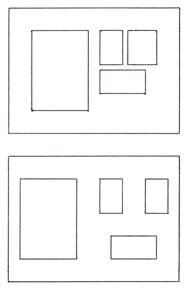 Diagram 2
Diagram 2
(A) The openings are placed too closely creating visual tension. The shape placement allows negative space dominates and draws attention to the lower right corner.
(B)Unless lettering or surface decoration is added there is too much negative space between the shapes.
Often the proper use of shapes in relation to placement and the creation of positive vs. negative space is instinctive. There are few hard, set rules for how far apart openings must be placed, or how many work well in a given outer perimeter shape. The art will tell you when the spaces are correct...if you listen.
Learning the basic elements will not stimulate you to consciously think of them every time you design a framed presentation. But by doing your homework you will often be better able to identify the element that isn't working well when a design appears wrong or slightly off. Shape is a bit nebulous by definition. It's much harder to label than line, color or texture, when counting elements, but it is every bit as important.
See you next month with "Intensity and Value" and in the mean time...mind your positives and negatives!
END
Copyright © 1994 Chris A Paschke
For more articles on mounting basics look under the mounting section in Articles by Subject.
Additional information on all types of mounting is found in:
The Mounting and Laminating Handbook, Second Edition, 2002,
The Mounting And Laminating Handbook, Third Edition, 2008 and
Creative Mounting, Wrapping, And Laminating, 2000 will teach you everything you need to know about getting the most from your dry mount equipment and materials as an innovative frame designer.
All books are available from Designs Ink Publishing through this website.
Chris A Paschke, CPF GCF
Designs Ink
Designs Ink Publishing
785 Tucker Road, Suite G-183
Tehachapi, CA 93561
P 661-821-2188
chris@designsinkart.com